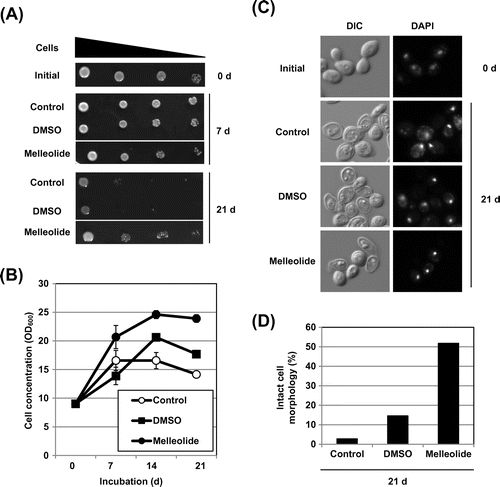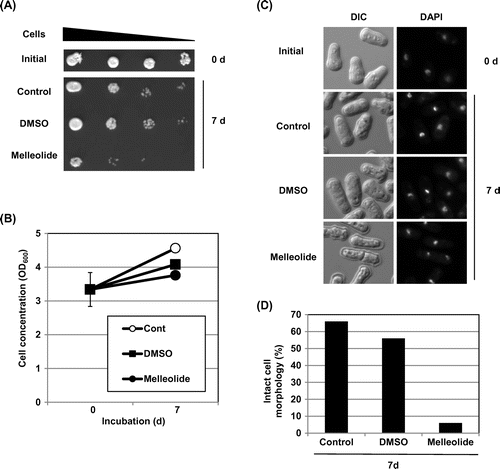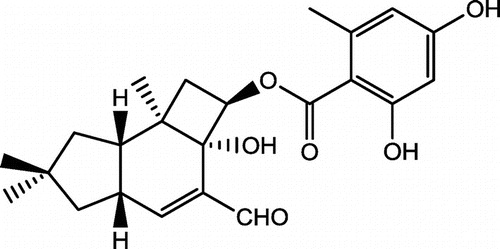Abstract
The chronological lifespan (CLS) of the budding yeast Saccharomyces cerevisiae is a model for the aging of post-mitotic cells in higher eukaryotes. In this study, we found that the sesquiterpene aryl ester melleolide expands the CLS of budding yeast. In contrast, melleolide compromised the CLS of the fission yeast Schizosaccharomyces pombe. This indicates that melleolide might have a potential anti-aging activity against some types of cell, and that it might be useful as a selective anti-fungal drug.
Aging is a degenerative process characterized by a progressive deterioration of cellular components, resulting in mortality. Cellular aging is deeply involved in the aging of organisms. Short-lived model organisms, such as yeast, have greatly contributed to our understanding of the molecular determinants and mechanisms of aging.Citation1) The budding yeast Saccharomyces cerevisiae has a chronological lifespan (CLS, the time cells stay alive in a non-dividing state in saturated culture) that is a model for the aging of post-mitotic cells in higher eukaryotes. The molecular mechanisms of cellular aging are conserved from budding yeast to humans.Citation2) Several proteins that affect aging in S. cerevisiae, such as the protein kinase target of rapamycin (TOR) and the histone deacetylase (HDAC) sirtuin, are conserved in higher eukaryotes. Addition of various compounds, such as the TOR inhibitor rapamycin, has a positive effect on the CLS of S. cerevisiae.Citation3)
No high-throughput screening methods for anti-aging compounds have been developed yet. Recently we developed a simple method to assess yeast CLS.Citation4) By this method, we identified the anti-aging activity of beauveriolide I, metabolites found in Basidiomycota, Cordyceps militaris, and Beauveria sp. FO-6979.Citation4) Here we searched for other Basidiomycota-derived anti-aging products.
Yeast cells of wild-type strain BY4741 (Mata leu2∆ ura3∆0 his3-∆1 met15∆0) were cultured overnight to stationary phase (an OD600 of about 8) in a YPAD medium (1% yeast extract, 2% peptone, 0.01% adenine, and 2% glucose) at 30 °C with agitation at 120 rpm. A 1-mL aliquot of the cell culture was transferred to glass test tubes containing various Basidiomycota-derived compounds, and these mixtures were further incubated at 30 °C with agitation at 120 rpm (day 0) to 21 days. Then, the cells were spotted on YPAD agar plates and cultured at 30 °C for 3 days. We estimated cell survivability by the formation of colonies on the plates.
In the course of this screening, we found that melleolide (Fig. ) was a potent anti-aging drug for the budding yeast. The sesquiterpene aryl ester melleolide and its analogs were purified from Armillaria mellea (naratake in Japanese).
Most cells of budding yeast die during three weeks of incubation under normal conditions (Fig. (A), control) but melleolide, though not the mock control DMSO, remarkably extended the CLS (Fig. (A)). Cell concentrations at the stationary phase during long-term culture were higher in the presence of melleolide (Fig. (B)). These findings indicate that melleolide improved cell vitality under nutrient-depleted conditions. Consistently with this, half of the cells maintained normal intact cell morphology with nuclei even after 21 days, like the 0-d cells (Fig. (C, D)). In contrast, there were few intact cells among the control cells (Fig. (C, D), control and DMSO). We concluded that melleolide remarkably improved the CLS of budding yeast.
Fig. 2. Melleolide improves the chronological lifespan (CLS) of S. cerevisiae. (A) Cells of wild-type strain BY4741 were incubated in YPAD medium for 21 days. DMSO (2%) or melleolide (400 μg/mL) was added at day 0. The viability of the cells was determined by colony formation in samples examined after 0, 7, and 21 days of incubation. Fivefold serial dilutions of cells were spotted in 1-μL drops onto YPAD plates, and this was incubated at 30 °C for 1 day. (B) Cells of BY4741 were incubated as described in panel A. The values of the cell concentrations (OD600) are shown as averages with error bars for two independent experiments. (C) Cells (BY4741) were grown and kept in YPAD medium for 21 days, as described in panel A. They were briefly fixed with 70% ethanol and then stained with 4′,6-diamidino-2-phenylindole (DAPI). Cell morphology (DIC) and 4′,6-diamidino-2-phenylindole (DAPI)-stained nuclei (DAPI) were observed. D, After 21 days of culture, the cells that maintain normal cell morphology were counted, and these are shown.

To test whether the anti-aging activity of melleolide is to be found in other fungi, we tested its effects on the fission yeast Schizosaccharomyces pombe. Fission yeast has a shorter CLS in YES media (0.5% yeast extract and 3% glucose) than budding yeast. Cells of fission yeast loose viability 7 days after incubation (Fig. (A), control). Surprisingly, melleolide compromised the cell longevity of fission yeast, whereas DMSO did not (Fig. (A)). Consistently, cell growth during incubation was suppressed in the presence of melleolide (Fig. (B)). In addition, the fraction of cells with aberrant cell morphology increased in the presence of melleolide after 7 days of incubation (Fig. (C, D), melleolide). These observations indicate that melleolide affects the CLS of budding and fission yeasts in a contrary way. Thus, melleolide acts as an anti-aging drug for budding yeast, but not for fission yeast.
Fig. 3. Melleolide compromises the cell longevity of fission yeast. (A) Cells of wild-type strain SHM34-6D (h−) were incubated in YES medium for 7 days. DMSO (2%) or melleolide (400 μg/mL) were added at day 0. The viability of the cells was determined by colony formation of samples taken at 0 and 7 days of incubation. Fivefold serial dilutions of cells were spotted in 1-μL drops onto YES plates, and incubated at 30 °C for 2 days. (B) Cells of SHM34-6D were incubated as described in panel A. The values of the cell concentrations (OD600) are shown as averages with error bars for two independent experiments. (C) Cells of SHM34-6D (h−) were incubated in YES medium for 7 days, as described in panel A. They were fixed and stained as described in Fig. 2(B). (D) After 7 days of culture, cells with abnormal cell morphology were counted, and these are shown.

It has been reported that melleolide showed anti-fungal activity against Cladosporium cucumerinum,Citation5) and that certain melleolide analogs exhibited anti-microbial activityCitation5,6) and induced apoptosis-like cell death in various types of human cancer cells.Citation7,8) It is likely that melleolide and its analogs show cell death activity against various types of cell, and that they show anti-aging activity specifically as to budding yeast cells.
In sum, this study indicates that melleolide can be useful as a selective anti-fungal drug and that melleolide can prolong the CLS of some types of eukaryotic cell. It is important to dissect the contradictory cytological effects of melleolide on diverse types of cells, because common mechanisms might be involved in promotion of lifespan and death.
Acknowledgments
We thank Dr. Ayumu Yamamoto (Shizuoka University, Japan) for providing S. pombe strain SHM34-6D. BY4741 was provided by the National BioResource Project (NBRP) of the Ministry of Education, Culture, Sports, Science and Technology (MEXT), Japan. This project was funded by the program of the Promotion of Nanobiotechnology research to support the aging and welfare society of the MEXT of Japan.
Notes
Abbreviation: CLS, chronological lifespan.
References
- Kennedy BK. J. Intern. Med. 2008;263:142–152.10.1111/jim.2008.263.issue-2
- Fontana L, Partridge L, Longo VD. Science. 2010;328:321–326.
- Evans DS, Kapahi P, Hsueh WC, Kockel L. Ageing Res. Rev. 2010;10:225–237.
- Nakaya S, Mizuno S, Ishigami H, Yamakawa Y, Kawagishi H, Ushimaru T. Biosci. Biotechnol. Biochem. 2012;76:1226–1228.
- Midland SL, Izac RR, Wing RM, Zaki AI, Munnecke DE, Sims JJ. Tetrahedron Lett. 1982;23:2515–2518. doi:10.1016/S0040-4039(00)87383-9.10.1016/S0040-4039(00)87383-9
- Donnelly DMX, Abe F, Coveney D, Fukuda N, O'Reilly J, Polonsky J, Prangé T. J. Nat. Prod. 1985;48:10–16.10.1021/np50037a002
- Misiek M, Williams J, Schmich K, Hüttel W, Merfort I, Salomon CE, Aldrich CC, Hoffmeister D. J. Nat Prod. 2009;72:1888–1891.10.1021/np900314p
- Bohnert M, Miethbauer S, Dahse HM, Ziemen J, Nett M, Hoffmeister D. Bioorg. Med. Chem. Lett. 2011;21:2003–2006.10.1016/j.bmcl.2011.02.026

